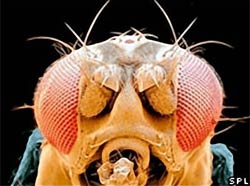Flies can help treat liver disease
A study of flies (probably sucking on sap) will probably find new treatments for liver and diabetes diseases in humans.
Scientists have found cells capable of melting fat in the Drosophila fly. The process is similar to that of humans, thus increasing the hope that this research will help develop new drugs.
This study was conducted by the National Institute for Medical Research and published in the journal Nature .
In humans, excess fat is rinsed in tissue form but cannot be absorbed or converted into energy during long breaks between meals. Important steps to transform fat molecules that convert them into energy for the body usually occur in the liver.

Flies Drosophila specializes in sucking plants
(Photo: SPL)
However, when people are obese, it leads to an imbalance in the amount of fat stored and fat dissolved in the liver. This can lead to two diseases like diabetes and metabolic disorders.
Flies give us some genes and are thought to be helpful in understanding some human diseases. But so far how they absorb fat is still a mystery. This limits the use of flies in the study of human liver disease and obesity-related diseases.
This new study shows that the task of resolving fat is carried out by a special cell, called oenocytes.
The leader of the study, Dr Alex Goul, said: 'These findings reveal that flies are quite similar to our liver, when they store, metabolize and burn fat, exactly the same. takes place in our bodies. We hope that the fatty liver sample in the fly Drosophila will help accelerate the testing of chemicals as new treatments for human liver diseases. '
The researchers also found that the fly has more than 20 genes that burn like fat in humans. Dr. Goul said that these findings will help us better understand the body's mechanism of storing and burning fat.
Dr. Iain Frame, director of research for the British Diabetes Foundation (charity Diabetes UK) said: 'Drosophila flies are often used in the field of diabetes research, so that we can help Know the cause of Type 2 diabetes. This is a very good study and is likely to bring new treatments, but it is currently in the beginning phase. '
Currently in the UK there are more than 2 million people with diabetes, and it is estimated that more than 750,000 others also have symptoms of the disease but have not been diagnosed.
Professor Chris Day of Newcastle University (University of Newcastle) said fatty liver disease is a major problem in the UK, and affects 30% of the population.
According to him, a majority of them will likely have cirrhosis, liver failure or liver cancer. 'The causes of these complications are still unknown. So the information presented in the Nature journal offers a perfect new model to study important mechanisms of the body, and this will certainly bring more effective preventive and curative measures. '
Manh Duc
- Fatty liver: Causes, symptoms and treatments
- 10 things you may not know about the liver
- New method to treat cirrhosis effectively
- Watch out for signs of fatty liver disease
- The first baby from deadly liver disease thanks to new technology
- Treat liver cancer with smallpox vaccine
- People with fatty liver should drink?
- Misconceptions about eating with people with liver disease
- Fruit flies die early because they cannot be loved
- Using the right amount of coffee can help protect the liver
- Should the food be thrown away as soon as the fly flies?
- Eating properly for liver patients
 Why do potatoes have eyes?
Why do potatoes have eyes? 'Tragedy' the world's largest carnivorous life: Death becomes ... public toilet
'Tragedy' the world's largest carnivorous life: Death becomes ... public toilet Tomatoes were once considered 'poisonous' for 200 years
Tomatoes were once considered 'poisonous' for 200 years Detecting microscopic parasites on human face
Detecting microscopic parasites on human face